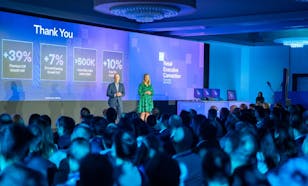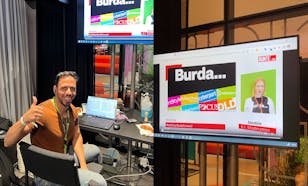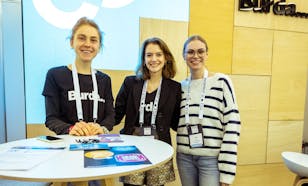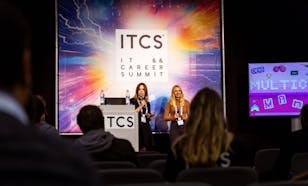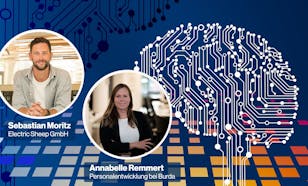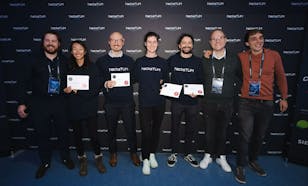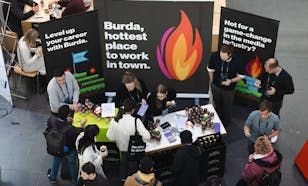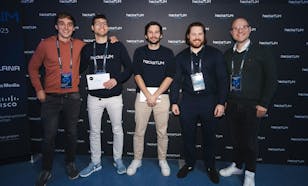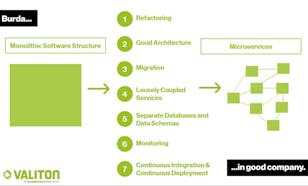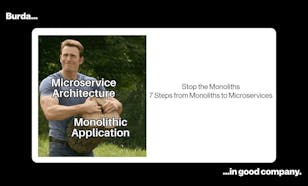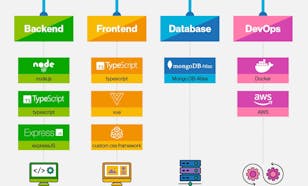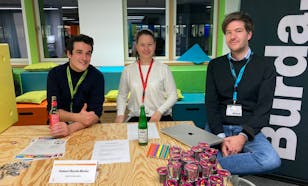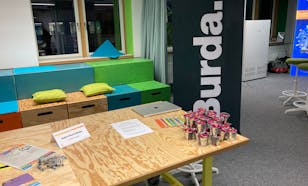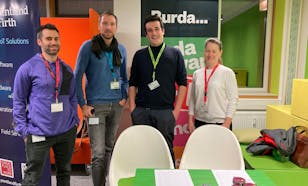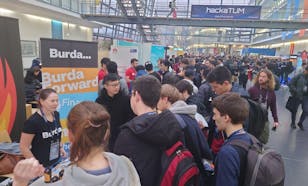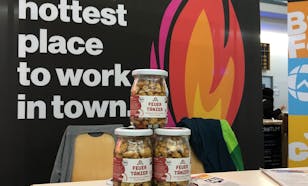

Hubert Burda Media
peopleEmployees
5001 or more
businessIndustry
eCommerce, Media and Content, Platform
account_balanceFounded
1903
dvrTech stack
Vue.js, React, JavaScript, TypeScript, PHP, Symfony, Node.js, Amazon Web Services (AWS)
gradeKey values
checkAwesome co-workers
checkEQ > IQ
checkHigh code quality
checkState-of-the-art technologies
checkPromotes opportunities
checkData-driven
linkLinks
Work at Hubert Burda Media
Join one of Europe’s largest media companies. We create digital media worlds and e-commerce shops to make our users’ lives a little better every day. Our recipe for success is courage, enthusiasm and a healthy portion of creative freedom.
We are looking for you to actively shape the changes taking place in the media world with us. Get involved in the dynamic world of media and find your ideal project as a developer, engineer, architect or administrator (m/f/d). Exciting tech jobs await you – along with wonderful colleagues. Just choose the right brand, tech stack and role for you among market-leading consumer products with millions of users, such as Holidaycheck, Focus Online and Chip.de.
We want to strike a healthy balance between the professional and private to achieve great things as a team. We trust in our colleagues and encourage them to take responsibility and fulfil their entrepreneurial aspirations. Here you can push ahead with your start-up ideas within the secure environment of a major corporation.
Einblicke, Begegnungen und Zukunftsimpulse für unser Business
Die Intel EMEA Retail Executive Connection ist eine jährlich stattfindende Veranstaltung, bei der sich der Branchenführer Intel mit Herstellern und ausgewählte Retailpartnern aus ganz Europa trifft. Ziel ist es, aktuelle Markttrends zu besprechen, strategische Partnerschaften zu stärken und einen Ausblick auf kommende Innovationen zu geben. In diesem Jahr fand das Event vom 28. bis 30. April 2025 in Rom statt – und wir (Tina & Matthias) waren mit dabei.
In nur anderthalb Tagen konnten wir viele intensive Gespräche führen – unter anderem mit Intel, Lenovo, HP, Asus, Acer, Samsung, MSI, Medion/Erazer und Google. Diese Gespräche bieten uns nicht nur Einblicke in kommende Produktneuheiten, sondern stärken auch unsere Rolle als relevanter Handelspartner auf europäischer Ebene.
Ein zentrales Thema war die Präsentation der kommenden Intel-Prozessor-Generation „Panther-Lake“ – eine Technologie, die unseren Kund:innen ab Q2/2026 in neuen Geräten begegnen wird. Ergänzt wurde das Programm durch spannende Keynotes von Microsoft und Google, die ihre Visionen für die Zukunft des digitalen Arbeitens und Konsumierens vorgestellt haben.
Auch die geplante Marktbegleitung zum Thema „Windows 10 End-of-Support“ ab der im September geplanten Back to School Kampagne war für uns ein wichtiger Gesprächspunkt. Hier wollen wir uns gemeinsam mit unseren Partnern stark positionieren.
Solche Veranstaltungen sind keine bloßen Branchentreffs – sie sind strategisch relevant. Sie stärken bestehende Partnerschaften, eröffnen neue Perspektiven und sorgen dafür, dass Cyberport frühzeitig in Produkt- und Marketingstrategien eingebunden ist. Das kommt letztlich nicht nur unseren Vertriebsteams, sondern auch dem Einkauf, Marketing, Kundenservice und vielen weiteren Bereichen zugute.
Wir freuen uns schon darauf, die neuen Erkenntnisse in unseren Alltag zu integrieren.
We had the pleasure of being part of the impressive career experience fair at “Medientage München”, where we showcased something truly extraordinary in our space: our own video AI tool.
"Magic AI" transforms your photo into a speaking avatar capable of moderating your videos. Currently, the tool is already being used for news moderation at Chip. Deceptively realistic moderation avatars inform viewers about current events without the need for expensive studio recordings.
Mark Luxenhofer originally aspired to become a film director but instead, with his interdisciplinary team, developed the AI-based tool whose potential extends far beyond creating news videos. What will be possible in the coming months remains to be seen.
What's behind it all? The Magic AI tool is based on three existing tools:
✍️ ChatGPT for the texts
👤 D-ID for the avatars of real people
🎤 EvenLabs for the voiceovers
At Burda, we are always on the lookout for the latest technology trends and new team members willing to test them with us. Our IT&Tech teams are excited to welcome innovative out-of-the-box thinkers. Explore our career opportunities. https://www.burda.com/de/karriere/entwickler/
Wer in der Tech-Welt zu Hause ist, dem ist der ITCS ein Begriff. Auch in diesem Jahr waren wir mit zwei Speakerinnen (und unserem Karrierestand) in München dabei, als sich die IT- und Tech-Größen auf dieser Messe trafen.
Im Tech Talk haben euch unsere Speakerinnen Simona Orlandi, Director Tech Operations, und Lea Wieditz, Technology Innovation Portfolio Manager, in eine 8-bit-Welt voller schwebender Plattformen und wirbelnder Datenwolken mitgenommen. Die Mission: Verbinde alle Clouds zu einem mächtigen Netzwerk und vereine unsere bunte Markenwelt in eine Multicloud.
“Beim Erarbeiten einer Multicloud-Strategie fühlt man sich manchmal ein wenig wie auf der Regenbogenstrecke von Mario-Kart… Wir haben es zum Glück geschafft, nicht runterzufallen.“ - Lea Wieditz
Warum eine eigene Multicloud sinnvoll ist?
Kostenersparnis, neue Features und weniger Infrastrukturarbeit für Devs. Doch es gibt noch viele weitere Vorteile, die die Multicloud mit sich gebracht hat.
Wie Simona und Lea die Multicloud erfolgreich implementiert haben, welche Herausforderungen sie dabei überwunden haben und welche wertvollen Erkenntnisse sie aus diesem Projekt gewonnen haben – all das präsentierten sie in vier spannenden Leveln während ihres Tech Talks.
Wer hier schon Feuer und Flamme mit Hubert Burda Media war, konnte an unserem Stand die spannendsten IT-Jobs entdecken und direkt mit unseren Recruiterinnen ins Gespräch kommen.
Du willst dein nächstes Level auch bei Burda bestreiten? Dann sieht dir unsere vielfältigen IT-Jobs an. Wir freuen uns schon auf den Zuwachs in der IT.
Bist du beim nächsten ITCS auch dabei?
🚀KI-Boom bei Burda – über 800 geschulte Mitarbeiter:innen! 🤖
Künstliche Intelligenz wird unseren Arbeitsalltag in Zukunft stark beeinflussen. Wir bei Burda möchten diese Chancen nutzen und die spannende Welt der KI erkunden und mitgestalten.
💡Dabei beziehen wir alle Mitarbeitenden mit ein und bieten unternehmensweit umfassende Schulungen, um den Umgang und erfolgreichen Einsatz von KI-Tools zu erlernen. „Wir wollen mit den Grundlagentrainings einen Rahmen schaffen, in dem die Mitarbeitende die Möglichkeit haben, verschiedene KI basierte Tools kennenzulernen und auszuprobieren. So können wir alle bei Burda gleichermaßen von den neuen Technologien und Innovationen profitieren.“, betont @Annabelle Remmert aus der Personalentwicklung die Wichtigkeit der Trainings.
🔥Seit August arbeiten wir erfolgreich mit @Sebastian Moritz von @Electric Sheep GmbH zusammen und haben mit den Basisschulungen einen guten Grundstein für die KI-Grundkompetenz der Belegschaft gelegt.
„Mir war wichtig, den Entdeckergeist zu wecken und die Teilnehmenden dazu zu animieren, die Tools auch auf eigene Faust zu erkunden und herauszufinden, was alles möglich ist. Ganz nach dem Prinzip: Hilfe zur Selbsthilfe.“, erklärt Sebastian.
💯Und die Rechnung geht auf: „Die Schulung hat mir wichtige Denkanstöße und Impulse gegeben, wie ich das Thema auch für meinen Arbeitsbereich, der nicht im redaktionellen liegt, einsetzen kann. Mein Blick hat sich geweitet und ich konnte gute Tipps mitnehmen.“, so ein Teilnehmer der „ChatGPT Basics Schulung“.
🔄Aber auch interne Bereiche sorgen für einen regen Wissenstransfer: Unser Product & Innovation Team teilt regelmäßig in verschiedenen Events & Formaten Basis-Wissen über KI und fördert das Lernen und den Austausch über erste Anwendungsfälle in den verschiedenen Bereichen.
Bei @BurdaForward wird sogar eine eigene generative KI entwickelt, die aus Bildern und Fotos automatisch Avatare und Bewegtbild erstellt. #moretocome
👑Unser krönendes KI-Highlight dieses Jahr: Der burdaweite AI Demo Day. 333 Tage nach dem Launch von ChatGPT wurden am 10.10. die vielversprechendsten KI-Ideen aus allen Bereichen präsentiert und prämiert.
Deine Meinung zählt: Mit welchen KI-Trends sollten wir uns in Zukunft noch mehr beschäftigen? Lass es uns wissen!
KI, IT und Tech bei Burda – jetzt über unsere Teams und spannende Jobs informieren: https://www.burda.com/de/karriere/entwickler/
#KI #Innovation #Weiterbildung #Burdakarriere
Bild: Unplash (Steve Johnson)
1,050 participants, exciting cases from leading industry partners and 36 hours of programming: hackaTUM, organized by the Technical University of Munich, has grown to be one of the largest of its kind in the EU.
“Discover the possibilities of artificial intelligence in the media industry”
With this task we entered the race. Mark, Teamlead AI Video at BurdaForward, provided the idea:
Explore how AI opens new possibilities in the media industry. Today, BurdaForward is already using an “Magic AI Tool”, that allows to create news videos from text within a few minutes. What shall we do tomorrow? As an inspiration, you could create a news show with different presenters and topics, or a Video Chatbot answering questions about news.
Two teams made it onto the shortlist and were able to pitch their development in front of hundreds of students and company representatives on the final day:
Voice Craft: the solution enables deaf-mute people to use AI-supported presentations with avatars to integrate them into the workplace. Python was used to extract comments from the PowerPoint file and feed them to D-ID API to retrieve the video of the presenter. A video will be generated of the slides with the same tempo as the video generated from the D-ID APIs. So two videos are combined inside a highly customizable template using Remotion.
TU minute papers: an app that uses AI to convert medical findings into a short video that patients can understand. Questions can also be asked to obtain information on risk factors or to compare the study with other studies. In the background, the tool uses OpenAI to analyze the paper and create a 5-fact summary. The five facts are sent to DALL-E to create accompanying images.
In addition to Mark Luxenhofer, Robert Detering, Executive Principal at BurdaForward and Christoph Caprano, Software Engineer at Valiton, were involved as jurors and evaluated the participants' pitches according to the criteria of innovation, quality, our interface & experience and presentation.
"The commitment of the participants is always breathtaking. I enjoy exchanging ideas with the students.Last year we were even able to get four of them to take part in an internal tech project," Robert, sums up.
Interested in opportunities for IT students or professionals? https://www.burda.com/en/career/developers/
What do an astrophysicist, an economic geographer, an economist and a microbiologist have in common? Exactly - they all work in Valiton's business performance team and deal with data science.
In the video, Christian, Angelika, Matti and Dennis explain what they are currently working on, how artificial intelligence can be used to predict future consumer behavior and how natural language processing can be used to optimize e-commerce platforms - and what working at Valiton is all about.
From monoliths to microservices: A Software Architecture Challenge
The transformation from a monolithic software structure to microservices is not always easy, but it has its advantages. The architecture is more flexible, scalable and facilitates the further development of the software.
Sven Sanzenbacher, team lead in the software development area at Valiton, a Burda company, shares how this transformation can succeed step by step.
Seven steps from monolith to microservices
- Step-by-step refactoring: It is advisable to refactor the monolith step by step. By applying principles such as “SOLID”, “Domain-Driven Design” and “Clean Architecture”, clear boundaries can be defined between components and individual reusable as well as independent modules can be created.
- Monoliths with good architecture: Monoliths with a good architecture can be broken down into microservices more easily. A well thought-out architecture already lays the foundation for a later migration.
- Step-by-step migration: Instead of breaking down the entire monolith into microservices at once, you should pull out individual services step by step. This enables a controlled and manageable transition.
- Loosely coupled services: A key aspect of microservices is that the services are loosely coupled. This is achieved by using message queues or a message bus, up to an event-driven architecture. This improves the decoupling and flexibility of the services.
- Separate databases and data schemas: each service should have its own database and data schema. This improves the independence and fault tolerance of the individual services.
- Monitoring and troubleshooting: Central log servers and distributed tracing are essential elements for monitoring and troubleshooting in a microservices environment. They enable better tracking of issues and facilitate troubleshooting.
- Continuous integration and continuous deployment (CI/CD): CI/CD are key strategies that make the process of testing and deploying microservices more efficient and reliable. They enable rapid iteration and ensure that changes reach production quickly and safely.
Conclusion
In summary, migrating to microservices is not an easy journey. It requires careful planning, step-by-step refactoring and a clear vision. Nevertheless, microservices offer many advantages, such as increased scalability, flexibility, and the ability to evolve individual services independently.
Anyone interested in software architecture and the challenges of migrating to microservices should keep the presented takeaways in mind. While the path to a microservices architecture requires time and patience, it can lead to more efficient and flexible software development in the long run.
Are you also on a mission to free the software world from monoliths and establish yourself in the tech space? Then Valiton is the right place for you.
Valiton is part of the large Burda family and brings exciting projects in the areas of data science, data engineering and software development in tech and media forward.
Find the job that suits you: https://www.burda.com/en/career/
Our vision is to make your application process as intuitive and helpful as possible with AI ✨
💡Our IT Talent Community Manager, Robin, and his team have developed the prototype "BCC - Burda Career Compass" for our first-ever AI Demo Day and shared it with the entire #burdaversum.
🤖The BCC is a chatbot that interacts with you, catering to your wishes and needs in job selection. This way, you get suggested suitable positions in no time and are guided through the application process.
We're curious - would you use the BCC? What could be improved in the traditional recruiting process?
We foster ideas, innovations, and the use of new technologies - for a better future. ✨
#burdakarriere #aidemoday #aiinnovation #jobs #recruiting #chatbot
Burda’s digital publisher brands, which include Focus Online, Chip and Bunte.de, are being united under the BurdaForward subsidiary. The various brands are decentralised and, for historical reasons, have their own IT architectures and developer teams who work with different programming languages.
Organised into “Jobs to be Done” teams, BurdaForward is no longer structured according to brands and products, but based on the jobs that the products perform for users. The “Content Technologies” team offers the individual “Jobs to be Done” teams a central content platform – a technical foundation. Job teams can work completely independently of the content platform, draw on complete services, or develop their own features on the content platform stack. All technologies used will be unified into a core tech stack that will be made available to the developers on the job teams.
We create media with people, for people and love to connect with people. This month we hosted HackerX in our office in munich – the world’s largest invite-only developer recruiting event. We met amazing like-minded people and hope to see you next time. Pizza and beer is on us 😊
Our Munich offices are part of one of Hubert Burda Media's largest locations. Experience our office culture in Arabellapark and on St. Martin Straße and get an insight into our offices and meeting places, including the beloved Burda Bar, impressions of our brands, the Felix Burda Foundation and our day care center BurdaBande.
Enjoy the beautiful Black Forest city Offenburg: midway between Karlsruhe and Freiburg, just 30 minutes drive away from Strasbourg and Europa Park (Germany's largest theme park)
We had lots of fun at the hackaTUM 2022 – the official hackathon of the Department of Computer Science at the Technical University of Munich. 12 teams of highly motivated participants of various levels and backgrounds worked on our case for StreamPicker "Help our users to find the best next stream". Hope to see you all in 2023 for the next coding challenge.
Developer jobs at Hubert Burda Media



